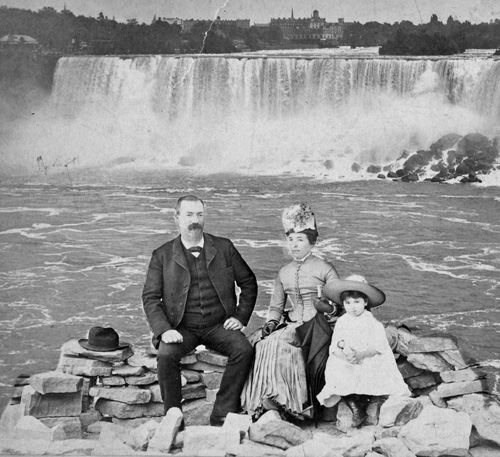Spring Quarterly features J.N. Weaver family history

SAYRE - The Spring issue of the Sayre Historical Society Quarterly features a cover story on the family of railroad master mechanic James N. Weaver. Included in the family history provided by Andrew Hammond is a story of legendary "Diamond Jim" Brady and his visit to Sayre.
CAPTION: James N. Weaver and family are pictured in this photograph from 1887. Weaver was a master mechanic for the railroad and Sayre's first burgess. The photograph is from the Andrew T. Hammond Collection.
"Diamond Jim Brady paid a call on Chief Engineer Weaver one day in 1891 to look at railroad locomotives that Mr. Weaver made for the Lehigh Valley Railroad in Sayre," according to Hammond's account. "With James Weaver in his shop that day was his 8-year-old daughter Nellie. Diamond Jim liked her, and, as a gift, gave her a diamond pin and a gold bead necklace."
According to Hammond the necklace remains in the Hammond family (James N. Weaver to Earl D. Hammond to George E. Hammond to Andrew T. Hammond) and is worn by a member of the family on their wedding day.
Other stories in the issue include an account on the construction of the Sayre tennis courts dating from the 1930's, the demolition of the "landmark" Railway Express Office in 1975 and an interview with Jim Lathrop, former engineer for the Lehigh Valley Railroad. The center picture of the issue has the 1959 Sayre High School baseball team from the Francis Hunt Collection. A story provided by Jim Nobles recounts the memory of Mrs. Katherine Goodall and the so-called "Foundry Row" of houses on the 600 and 700 block of N. Lehigh Avenue. The account is illustrated by Dana Twigg.
In the cover story, Hammond recounts the interesting life of Weaver, who served as Sayre's first burgess (or mayor).
"James served in the Union Army during the Civil War and fought Confederate forces in Virginia as a member of the 129th Regiment of the Pennsylvania Volunteers," said Hammond. "James ran away from home at the age of 14, enlisting as a drummer boy and rose through the ranks, fighting for the duration of the war, albeit he was taken prisoner at Kelly's Ford, Fredericksburg, Virginia at age 18, imprisoned at the infamous Libby Prison, and later released at City Point, Virginia."
Weaver was master mechanic in the original railroad shops in the 1880's and was Sayre's first burgess as well as the first postmaster, according to Hammond.
Included with the story are pictures of the Weaver family in 1897 and a wedding photograph of Nellie Weaver Hammond from 1908.
The story on the tennis courts recounts the efforts of Sayre businessman Sydney Glaser to establish courts at the new Sayre High School. Funds were raised from subscribers including the Sayre Lions Club, the Evening Times newspaper, the First National Bank and the Sayre Land Company. Additional funds were raised by a dance and the sale of membership tickets. A letter from Harry C. Child thanked Glaser for his efforts and asked that the membership be transferred to his teenage daughter.
"I am returning my ticket with the request that you make it out to Catherine Child, 16, in my place, as I am a little careful about taking very violent exercise," the letter stated.
The article said the site of the football field at the high school was formerly referred to as Mason's Pond and the tennis courts were built on a site once known as "Frog Hollow."
The Railway Express office had been a landmark in Sayre for many years, according to the article. Located on S. Lehigh Avenue just south of the Packer Avenue Bridge, it housed the Railway Express Agency for many years after being first constructed as the railroad's first freight station.
The article includes two photographs taken by railroad historian Chuck Yungkurth, a mechanical engineer whose scale drawings were used by "historians, model manufacturers, model builders and publishers," according to his 2016 obituary.
Another noted historian, Herbert Trice of Auburn, interviewed Sayre's Jim Lathrop in 1982. The interview was provided by Richard Palmer of Syracuse.
"Jim Lathrop came to the house in the evening and we spent some time discussing his days on the railroad," according to Trice. "At that moment, I was researching the milk business. Since the milk trains were discontinued in 1948 and Jim went on the LV in 1937, his experience covered only its latter days and its more modern aspects, i.e. the use of tank cars. However he did remember the business of handling milk cans due to his early exposure to the railroad, and gave the best account of it I have heard so far."
The issue concludes with a photograph from the Willard Keeler Collection of six men who retired from the Lehigh Valley Railroad in 1956, a timetable for the Pennsylvania & New York Canal and Railroad Company from 1868 and a photograph by the late Robert Gauss of the bandstand in Howard Elmer Park in Sayre.
The Quarterly is a membership benefit and is delivered through the mail four times a year. The current issue and past issues of the Quarterly are available by contacting the museum at sayrehistorical@yahoo.com or by calling 570-882-8221.
